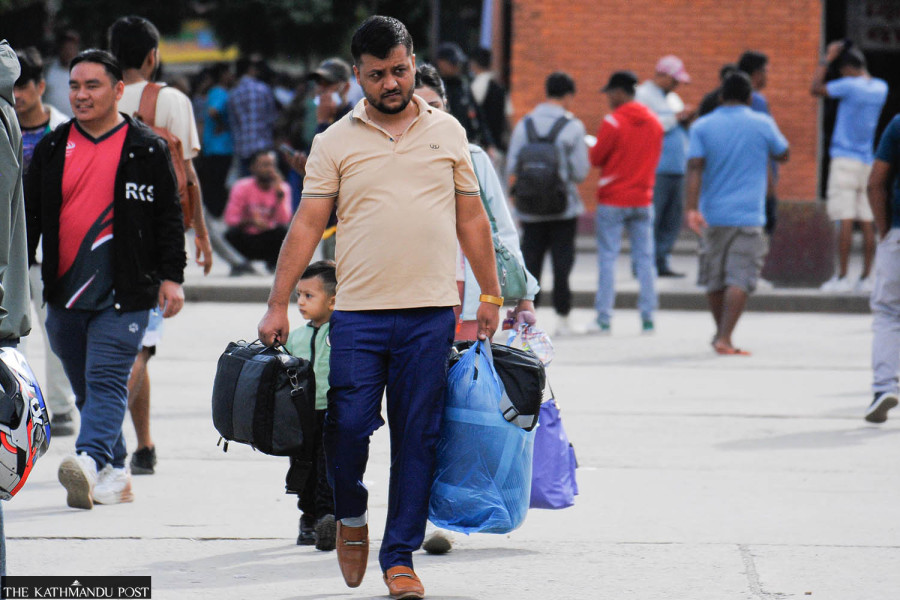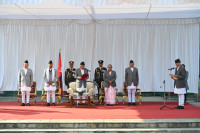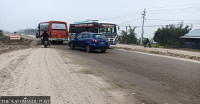National
Despite roadblocks, around half a million people have already left Kathmandu Valley for Dashain
Traffic police have set up help desks to combat festive ticket scams, while consumer rights activists lament travellers are still falling victims to scams.
Purushottam Poudel
Despite poor road conditions, the Dashain travel rush has not been as severely impacted as anticipated, with nearly 400,000 people having already left the Kathmandu Valley, according to the Valley Traffic Police Office.
Rabin Karki, a DSP at the Valley Traffic Police Office, said around 400,000 people have already left the Valley by road since the Dashain festival started on October 3.
DSP Karki said the number is, however, much lower compared to past Dashains, even though many are eager to visit their home districts for the festival.
The government has suspended night bus services on September 26 and 27 following heavy rain forecasts by the Department of Hydrology and Meteorology.
“The widespread damage and disruptions caused to major highways by recent rains might be the reason for the drop in the number of Dashain travellers,” Karki told the Post.
Most of Nepal saw record rainfall from September 26 to 28. Before the rains, the traffic police had estimated that at least 1.8 million people would leave the Valley for Dashain this year.
Transport operators, meanwhile, claim that over half a million people have left the Kathmandu Valley using various exit routes.
Saroj Sitaula, senior vice-chair of the transport operators’ federation told the Post that poor road conditions have disrupted vehicular movement making e-ticketing ineffective and as a result, it has become difficult to properly track the number of people leaving the Valley. But citing rough estimates, he said over half a million people have already left.
He said his estimate was based on the number of vehicles leaving the Valley and travellers flying out of the Valley are not included in this count.
Likewise, to ensure a smooth travel experience during Dashain, traffic police have set up help desks at 14 locations in Kathmandu to protect travellers from ticket scams, said DSP Karki.
“Plainclothes police have been deployed in various places to monitor the movement of travellers,” Karki said. “Also, we have coordinated with the district police offices to station excavators at key points along the highway to prevent older vehicles from causing disruptions.”
To make travel easier for the people from Kathmandu Valley across the country during the Dashain festival, the government gives road permits nationwide to all vehicles every year. Due to this, many old vehicles usually cause traffic jams on the highway, disturbing the movement of other vehicles.
The government has also halted cargo vehicle transportation, considering people's movement during the Dashain festival.
Consumer rights activists say the movement of people during the Dashain festival is not normal, and therefore, the normal state apparatus won’t be able to monitor the situation.
Each year, in light of the Dashain travel rush, the government issues road permits for all vehicles to facilitate travel across the country. However, because of this policy, even older vehicles that normally ply shorter routes, also take longer routes in hopes of capitalising on the increased demand. And this can, sometimes, lead to breakdowns and traffic jams, blocking highways for several hours.
What role can consumer rights activists play during such a time?
When asked, Jaya Prasad Paudel, secretary of the Forum for Protection of Consumer Rights Nepal, said that their organisation operates as a voluntary group and has limited influence.
“We can raise awareness and provide feedback to the government regarding the problems faced by travellers. And we have been actively doing this,” he said, adding, “But when most people are willing to be cheated, just to go home, there isn’t much we can do.”
Paudel said the help desks set up by police and other agencies cannot function effectively when they have to handle large crowds of travellers.
DSP Karki, meanwhile, acknowledged the difficult conditions under which these help desks operate during the travel rush. “I need to investigate this issue,” he said.




 11.12°C Kathmandu
11.12°C Kathmandu















